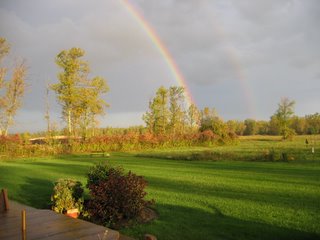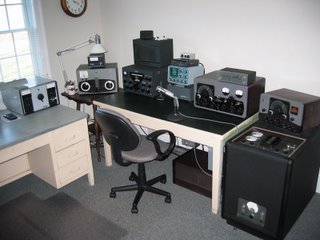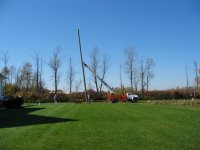AMATEUR RADIO STATION K2VXV
 Welcome to the weblog of K2VXV (Northern Half of the Buffalo Kilowatt Bookends), here you will find information dealing directly with this station.
Welcome to the weblog of K2VXV (Northern Half of the Buffalo Kilowatt Bookends), here you will find information dealing directly with this station.The station is located in the country on 6+ acres of farm property, 25 miles northeast of Buffalo, NY . As is seen in the photo, there is plenty of room for erecting antennas, and there is no man made noise to interfere with reception. All wires entering the radio complex from the outside world are located underground.
If there is a power failure, a 15 kilowatt natural gas powered generator automatically starts up and provides electricity to power the entire radio complex. This is very reassuring, especially during the long winter season here in Western New York.
K2VXV operates AM, FM, and SSB modes with power levels up to the legal limit.
AM OPERATION
On the AM side of the radio room, all of the transmitting and receiving equipment was manufactured in the 1950's. Included is the EF Johnson Viking Kilowatt which is driven by the Viking Ranger I, and the EF Johnson Viking 500 transmitter.
The Johnson Kilowatt can operate at two power levels, 300, or 1000 watts dc input, making it a rather flexible AM/CW transmitter. It has continous frequency coverage from 3.5 Mhz to 30.0 Mhz. (click on photo to enlarge)

The Viking 500 transmitter will operate at 500 watts AM and 600 watts CW dc input, and covers 80 through 10 meters on AM and CW.
The Viking Ranger I, one of the most popular transmitters that EF Johnson manufactured, covers 160 through 10 meters. It is a 75 watt CW or 65 watt phone rig that will also serve as an RF and audio exciter for the high power Viking Kilowatt amplifier.
The receiver used for the AM operation is the well known Collins 75A4, which is probably one of the top ten all time receivers ever made. In the receiver, you will find 3.1 Khz, 6.0 Khz, and 9.0 Khz mechanical filters, which provide excellent selectivity for AM and SSB reception. It was designed expresssly for amateur operation on 160 through 10 meters, and has precise dial calibration and high stability.
SSB OPERATION
When operating SSB, K2VXV uses vintage equipment from the RL Drake Company that dates back to the 1970's. The world famous Drake C-line, which consists of the R-4C receiver and the T-4XC transmitter provides 200 watts pep input. Like the 75A4, the Drake R-4C is probably one of the top ten all time receivers ever made.
These two units were purchased new in 1979, and have very high serial numbers. This indicates that they were one of the last units made before the C-line was discontinued.
Completing the SSB line up at the station, the Drake T-4XC transmitter feeds into a Henry 2KD-5 linear amplifier
 which provides power output at the full legal limit. The 2KD-5 uses a pair of 3-500Z's operating in a grounded grid circuit. The amplifier covers 80 through 10 meters.
which provides power output at the full legal limit. The 2KD-5 uses a pair of 3-500Z's operating in a grounded grid circuit. The amplifier covers 80 through 10 meters.The microphone used for both the AM and SSB operation is the Electro Voice 664 cardioid dynamic. This microphone was a favorite back in the 1950's, and was considered one of the high end microphones at that time. It still is very much in demand today.
ANTENNA SYSTEM
The antenna system used at the station, is a homebrew wire array known as the "40 meter extended double Zepp." The gain of this antenna over a half-wave dipole is approximately 3 db. Feeding it with open wire feed line, and using the EF Johnson Kilowatt Matchbox antenna tuner, this antenna performs very well on all bands, on any frequency, with an SWR ratio of 1:1.
The antenna center at 52 feet, is supported by a 60 foot utility pole which was installed on the property 80 feet away from the radio complex. The VHF/UHF antenna extends 8 feet above the top of the pole. (click on photo to enlarge)



Photos (top > bottom): pole in place at 60 feet, errecting utility pole, vhf/uhf antenna
OPERATING SCHEDULE
K2VXV has no set operating routine, but can be heard on the 75, 40, 15, and 10 meter bands on both AM and SSB, and on SSB on the 20 meter band. Most often the station will operate AM on the 75 meter band during the fall and winter season, usually in the late afternoon, between 3810 and 3830 Khz.
OPERATING SCHEDULE
K2VXV has no set operating routine, but can be heard on the 75, 40, 15, and 10 meter bands on both AM and SSB, and on SSB on the 20 meter band. Most often the station will operate AM on the 75 meter band during the fall and winter season, usually in the late afternoon, between 3810 and 3830 Khz.
